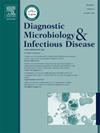硬膜肠球菌心内膜炎伴人工瓣膜及植入式电子装置并文献复习
IF 2.1
4区 医学
Q3 INFECTIOUS DISEASES
Diagnostic microbiology and infectious disease
Pub Date : 2025-06-14
DOI:10.1016/j.diagmicrobio.2025.116957
引用次数: 0
摘要
杜兰肠球菌是一种非常罕见的感染性心内膜炎的病因。迄今为止,文献中仅报道了9例由durans引起的心内膜炎或心脏植入式电子装置(CIED)感染。男性,48岁,高血压,非缺血性扩张型心肌病,既往主动脉瓣置换术,心脏再同步除颤器植入,虚弱,厌食,恶心,呕吐,体重下降7个月。经胸超声心动图显示主动脉瓣上有一个10毫米的可移动植被。入院24-72小时内,在3组血培养中培养出对氨苄西林和庆大霉素敏感的杜兰肠球菌。发生脓毒性栓塞并发症的患者经庆大霉素和氨苄西林治疗6周成功。杜兰肠球菌是一种非常罕见的感染性心内膜炎的病因,其危险因素、自然史和治疗反应尚不清楚。对于生物假体瓣膜和CIED患者,应牢记这种罕见且潜在高死亡率的感染因子。本文章由计算机程序翻译,如有差异,请以英文原文为准。
Enterococcus durans endocarditis with prosthetic valve and implantable electronic device and literature review
Enterococcus durans is an extremely rare cause of infectious endocarditis. To date, only nine cases of endocarditis or cardiac implantable electronic device (CIED) infection due to E. durans have been reported in the literature. A 48-year-old man with hypertension, non-ischemic dilated cardiomyopathy, previous aortic valve replacement and cardiac resynchronisation implantation with defibrillator presented with weakness, anorexia, nausea, vomiting and weight loss for 7 months. Transthoracic echocardiography showed a 10 mm mobile vegetation on the aortic valve. Ampicillin and gentamicin-sensitive Enterococcus durans was grown in 3 sets of blood-cultures within 24-72 hours of admission. The patient who developed septic embolism complication was successfully treated with gentamicin and ampicillin for 6 weeks. Enterococcus durans is an extremely rare cause of infectious endocarditis whose risk factors, natural history and response to treatment remain unclear. This rare and potentially high mortality infectious agent should be kept in mind in patients with bioprosthetic-valves and CIED.
求助全文
通过发布文献求助,成功后即可免费获取论文全文。
去求助
来源期刊
CiteScore
5.30
自引率
3.40%
发文量
149
审稿时长
56 days
期刊介绍:
Diagnostic Microbiology and Infectious Disease keeps you informed of the latest developments in clinical microbiology and the diagnosis and treatment of infectious diseases. Packed with rigorously peer-reviewed articles and studies in bacteriology, immunology, immunoserology, infectious diseases, mycology, parasitology, and virology, the journal examines new procedures, unusual cases, controversial issues, and important new literature. Diagnostic Microbiology and Infectious Disease distinguished independent editorial board, consisting of experts from many medical specialties, ensures you extensive and authoritative coverage.

 求助内容:
求助内容: 应助结果提醒方式:
应助结果提醒方式:


